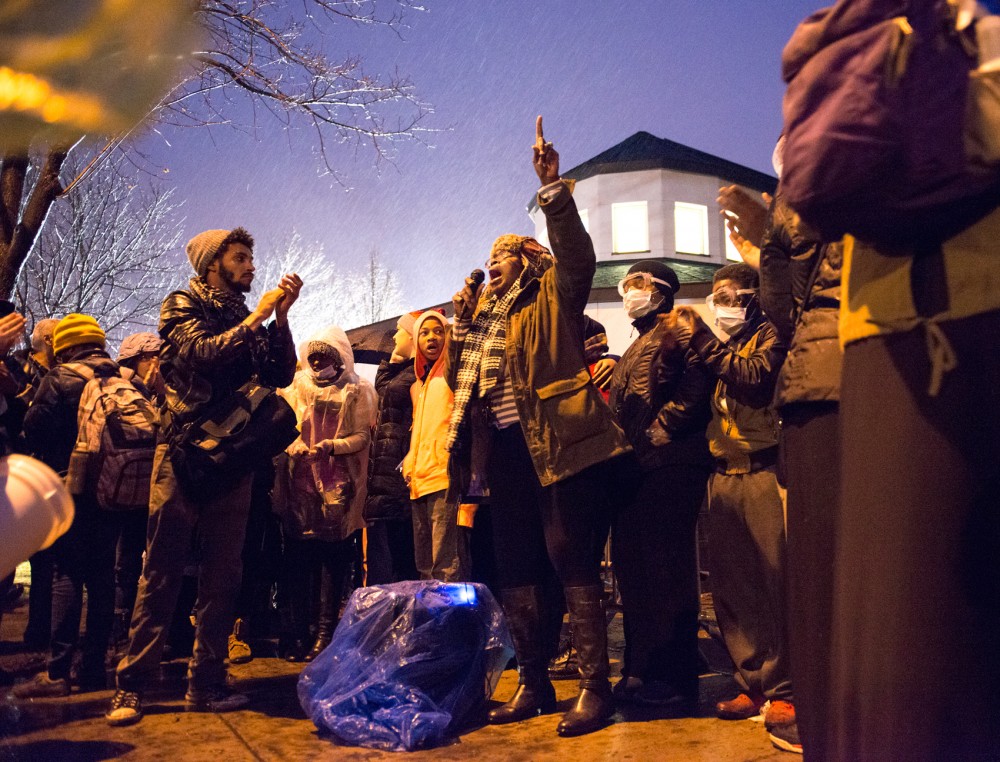Sprays of chemical irritant mixed with freezing mist in the air outside Minneapolis’ 4th Precinct Wednesday night as police officers attempted to break up the demonstrators who had occupied part of the station since Sunday.
Since the fatal police shooting of 24-year-old Jamar Clark on Sunday, the city has seen continuous protests led by Black Lives Matter Minneapolis. On Wednesday evening, a crowd of hundreds rallied outside the precinct, among them University of Minnesota students.
Montana Filoteo, a gender, women and sexuality studies junior from the University, said she came to the precinct after Black Lives Matter called for backup to keep the group from being pushed out of the space by law enforcement.
Law enforcement has maintained that Clark was trying to disarm police during a physical altercation and deny witness claims that Clark was in handcuffs when he was fatally shot in the head.
“We are here to get justice for Jamar,” Filoteo said.
She and other University students said Clark’s death and the resulting turmoil called them to action.
Earlier this week, demonstrators pressed for an independent investigation into the incident, identification of the officers involved and the release of video footage of the shooting. The first two demands have since been met.
On Thursday, Minnesota’s Bureau of Criminal Apprehension — which is leading an investigation into Sunday’s early-morning incident — named Mark Ringgenberg and Dustin Schwarze as the officers involved. The U.S. Department of Justice has also launched an inquiry for possible federal civil rights violations.
Michael McDowell, a founding organizer for Black Lives Matter Minneapolis, said that rallies would continue at the precinct until video is released.
He said more people showed up than he expected at Wednesday’s rally, where “Release the tapes” was a popular chant.
“People started pouring in from every angle,” he said.
At points, some protesters became aggressive, but organizers sent out “marshals” to deal with them before they got out of hand, he said.
“I’d rather be pushed than have someone push a police officer,” McDowell said.
Jesse Meisenhelter, a political science senior at Macalester College, said she had been considering participating in the Black Lives Matter movement for some time. Clark’s death prompted her to finally act, she said.
“I’ve always wanted to get involved; this was the most straightforward way to do that,” she said.
On Wednesday afternoon, officers began attempting to clear protesters’ encampments. Their efforts were soon stymied by a human chain that formed outside of the precinct’s chain-linked perimeter.
“We’ve shut this place down,” said McDowell. “We’ve locked them in here.”
Throughout the day, demonstrators faced off with dozens of Minneapolis police officers while chanting phrases including, “Hands up, don’t shoot,” and “Handcuffs, don’t shoot.”
At around 8 p.m., the bottles and gallon jugs that protesters had earlier filled with milk were put into use when officers sprayed chemical irritant at the crowds through the precinct’s fence.
Minneapolis Police tweeted that at least one officer was also hit with irritant sprayed from the crowd.
No one appeared to have been seriously injured in the course of the night’s events.
“I really appreciate the peaceful, restrained nature of the protest,” said Ward 2 Councilman Cam Gordon. “I wish we would do more as a city to support the protests in the face of this serious and critical time after a terrible killing.”
Earlier this week, hundreds blocked Interstate 94-West, demanding that video footage of the incident be made public. The highway’s shutdown ended with 51 arrests.
A number of protesters at the precinct Wednesday declined to speak with members of the media — including one woman dressed in University of Minnesota attire.
“I’m here for my community, not for a story,” she said.








